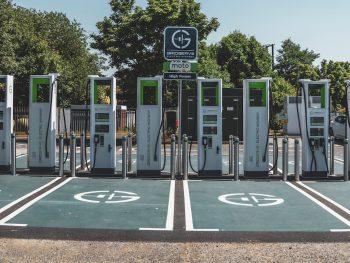Gridserve uses second-life batteries and vegetable oil generators to tackle grid constraints
Gridserve is working to speed up EV charger activation with an interim microgrid solution that uses second-life batteries and vegetable oil.

The interim microgrid solution has enabled Gridserve to open six of the new chargers at its latest Electric Super Hub site in Moto Ferrybridge
The first deployment of its type, the system is being used to power new ultra-rapid chargers at the EV charging technology firm’s latest Electric Super Hub site in Moto Ferrybridge, months ahead of when the grid connection would have otherwise been available.
It’s enabling the company to open six of the new chargers now to support charging needs of customers travelling across the M62/A1(M) and those in the local area.
Once the permanent grid connection is in place in the next few months, the site will have 12 high-power chargers.
The microgrid solution features a 150kW/150kWh battery pack, sourced from second-life car batteries, which controls the supply of power to the EV chargers and is supplied by vegetable oil generators, maximising overall efficiency and reducing noise output.
Vegetable oil generators produce 90% less carbon emissions than traditional generators – but in order to stay net zero, Gridserve is also planting trees to offset the remaining 10% carbon emissions this process is unable to remove.
Gridserve said it’s trialling the solution to “accelerate the energisation timeframes”. The subject of grid connections is coming under increasing scrutiny due to the expense and time involved and National Grid has recently stated that reforms to the process are urgently needed.
Gridserve has said that getting new Electric Super Hubs online often isn’t straightforward. Over the course of anywhere from six to 18 months, it works with landowners, adjacent business owners, local councils, contractors and Distribution Network Operators (DNOs) to launch new locations. Any delay, at any stage, could postpone the business from delivering the new Electric Super Hub, and over time this can have a knock-on effect on timelines for projects going live.
The new solution further demonstrates its commitment to delivering “world-class EV charging throughout the UK in the earliest possible timeframes”.
Toddington Harper, CEO, said: “We are focused on meeting the Government’s target of delivering at least six High Power chargers at our motorway partner locations by the end of this year. Electric Super Hubs typically require new grid connections, which are outside of our control and often take much longer to deliver than installing all the chargers.
“As a result, we’ve been working through solutions to get chargers working as quickly as possible, and we are excited to trial this microgrid solution running on batteries and vegetable oil, as this has enabled us to get the chargers operating many months before the grid connection was available.
“It’s not a perfect solution; hence, to maintain net zero we have arranged to plant trees to offset any carbon emissions produced, but on balance, as an interim solution we feel it makes sense.”
Harper added: “Of course, if there are people out there who have even better interim solutions that can be delivered within the timeframes we are working to, we would be delighted to hear from you.”












